While managing a campaign for a North Carolina state senator whose district included all but one of the six highest peaks east of the Mississippi, it fell to me to prepare the biscuits we’d occasionally offer at breakfast meetings of Democratic women’s clubs and retired teachers’ unions. I don’t bake, I explained. The senator was unfazed. “Get you a can of frozen biscuits and a Honeybaked ham,” he counseled, and those sandwiches turned out to be the hit of the election season.
Biscuits don’t have to be made from White Lily flour and lard to count as Southern. I’d venture our lightly fraudulent biscuits—made with equal parts dextrose, cottonseed oil, conviction, and spunk—were as Southern as anything beaten in a bowl. What most restaurateurs beyond the region miss when trying to reproduce its iconic dishes is that the South’s soul doesn’t reside in specific recipes; it’s found in the attitude of the headstrong folks who preserve their kitchen culture’s eccentric splendor, who swear by frozen biscuits or slaw dressing in their deviled eggs or vinegar in their cakes. Heather Earnhardt, the talented baker behind The Wandering Goose, a wisp of a daytime restaurant in Capitol Hill, is one of those folks.
Earnhardt’s buttermilk biscuits don’t originate in some faraway Yankee factory: The dense, knotty biscuits are made in-house. Like a second-string Hollywood star, the biscuits are tanned but not especially tall, and sufficiently sturdy to withstand whatever’s thrown at them. Standard fillings include fried chicken, bacon, and eggs, although burgers occasionally pop up on the specials list. More apt to flex than flake, the sometimes-slanted biscuits aren’t the city’s best—that honor belongs to Nook in the U District—but they’re perhaps the most personal biscuits regularly involved in retail transactions. The Wandering Goose’s idiosyncrasy alone would establish it as Seattle’s most credibly Southern restaurant, but Earnhardt gilds the magnolia with lampshades fashioned from flour sacks and a Mumford & Sons soundtrack.
Unfortunately, the three-month-old restaurant is so taken with its doing-it-my-way approach that customers can feel like an afterthought. The Wandering Goose’s shotgun room, which shares an interior wall of paneled windows with Rione XIII, officially seats 30, but that figure includes at least a dozen diners bound to be irritated by the closeness of the next table. And if the quarters feel tight before lunch, the situation only gets worse once the food arrives, as it’s impossible to make oneself momentarily skinnier while eating fried oysters and gravy. The warmly lit room is charming, from its wooden round-back spindle chairs and tables embossed with whimsical phrases to its glassed-in mercantile case of homespun pastries and stenciled wall, but there’s just not enough space to share.
While I appreciate staffers’ reluctance to enter the fray, I’m not sure the restaurant’s counter-service strategy makes sense in light of the physical constraints. Jumping up for condiments or a glass of water is complicated when your path’s blocked by neighboring diners, and the inevitable pre-order table grabs are a perpetual source of unnecessary tension. Also, the kitchen’s not speedy: On my first visit, we waited nearly 30 minutes for our soup, sandwiches, and side dishes. That’s an eternity at a restaurant table when nobody’s checking in.
But if you don’t have to rush back to work, spending a few extra minutes in your allotted sliver of the restaurant may not grate. The Wandering Goose makes good use of its time, excelling at dishes which can’t be slapped together. And the quick fixes aren’t too shabby either: Behold a biscuit sandwiching peanut butter and sliced bananas, its bottom layer ladled with sticky, floral honey produced by Earnhardt, who first got Seattle’s attention while running the Volunteer Park Cafe with Ericka Burke.
Still, the standout on the biscuit menu may be a slightly squishy sweet-potato biscuit, garnished with a runny fried egg, crisped at its edges; a flap of salty country ham, pink as a rubber Spaldeen; and a smear of butter infused with cane syrup. The sandwich alluringly evokes the dregs of the finest breakfast plates, with sweet, pork, and yolk fusing into a handy bundle of deliciousness.
Minimalists can have their biscuits with butter and jam, or a side saucer of sepia-toned sage gravy, which didn’t have a very strong showing the day I tried it. It was floury in pockets, and none of its component herbs made up for the missing salt. Nor did it cling the way a rustic gravy should, instead slipping off biscuits swiped through the gravy pot. Still, the gravy represented a rare letdown in the vegetarian realm: The Wandering Goose successfully serves sweetish braised greens, Sea Island field peas (a legume that traditionally shows up in hoppin’ John), granola with sorghum syrup, and a really remarkable vegetable hash.
Presented in a rectangular cast-iron dish, the hash features a rotating cast of roasted vegetables. On a late fall day, wonderfully bitter Brussels sprouts with charred outer leaves are tucked among the season’s subterranean stars, including potatoes and cipollini onions. Two thinly jacketed poached eggs, primed to spill their orange yolks, crest the mix.
Nearly as good is the gumbo, based on a ruddy roux and seeded with tender shreds of chicken, bits of salty pork, peppers, and onions. The gumbo has a lovely vestigial smoke, like scotch on a drinker’s breath. Yet what makes the soup is the seasoning, and a bowlful is likely to quickly vanish in a flurry of scrutinizing spoonfuls.
As for the sandwich side of the menu, the Goose and I have a difference of pimento-cheese opinions. Folded into orecchiette and baked, the cheese surrenders its assumed pungency and sharpness; but even without macaroni to mask it, the bland cheese doesn’t have much in the way of Dixie funk. It’s whipped into fluffiness for a grilled pimento sandwich, which is inexplicably served cold. Another sandwich featuring fried oysters and Benton’s bacon—a welcome tic in restaurants expressing their Southern allegiance—suffers from being seated between two too-thick slices of bread.
But all’s forgiven in the face of chef Michael Law’s fried chicken, with a crisp crust as dark as saddle leather. The greaseless chicken is chin-drippingly juicy, and if its breading’s missing a hit of pepper, there’s housemade hot sauce on the side. For dessert, there might be a crescent-shaped hand pie crammed with tart grape jelly. It’s not a sweet which appears on most lists of Southern classics, but the refreshingly iconoclastic Earnhardt makes it intuitively and beautifully. E









